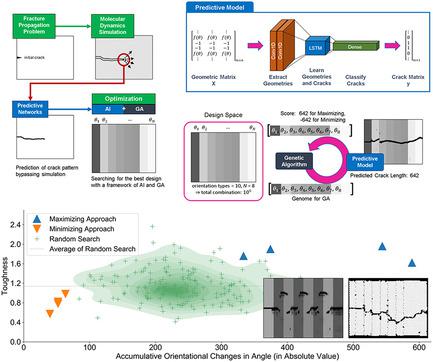当前位置:
X-MOL 学术
›
Adv. Eng. Mater.
›
论文详情
Our official English website, www.x-mol.net, welcomes your
feedback! (Note: you will need to create a separate account there.)
Tuning Mechanical Properties in Polycrystalline Solids Using a Deep Generative Framework
Advanced Engineering Materials ( IF 3.4 ) Pub Date : 2020-12-19 , DOI: 10.1002/adem.202001339 Yu-Chuan Hsu, Chi-Hua Yu, Markus J. Buehler
Advanced Engineering Materials ( IF 3.4 ) Pub Date : 2020-12-19 , DOI: 10.1002/adem.202001339 Yu-Chuan Hsu, Chi-Hua Yu, Markus J. Buehler

|
A framework for inverse design of tuning mechanical properties of polycrystalline brittle materials is presented using artificial intelligence (AI). Crystalline solids, which often exhibit distinct mechanical properties at different orientations, can be used as building blocks for polycrystalline composites. However, the design space of geometry and crystal misorientations is typically intractable, and all possible solutions cannot be discovered using experiment or numerical simulation. Herein, a framework using deep learning (DL) alongside a genetic algorithm (GA) is adopted to generate composite polycrystalline materials, whereas the raw material is brittle and sensitive to crystalline orientation, to achieve distinct mechanical properties in various combinatorial designs. The DL model, trained by full‐atomistic simulations of crystals with different orientations, evolves autonomously to yield a desirable range of target toughness values, exemplified in maximizing and minimizing toughness, which are validated by molecular dynamics (MD) simulations. It is found that higher crystal misorientations are preferred for high toughness, as opposed to lower overall misorientations for low‐toughness designs. Notably, this shows that a mechanism can be extracted from the AI algorithm. This materiomics method may ultimately change the way nanomaterials are designed, and can be applied to de novo biomaterial design, architected materials, and bioinspired structural materials.
中文翻译:

使用深度生成框架调整多晶固体中的机械性能
利用人工智能(AI)提出了用于调节多晶脆性材料机械性能的逆向设计框架。通常在不同方向上表现出不同机械性能的结晶固体可用作多晶复合材料的基础材料。但是,几何形状和晶体取向错误的设计空间通常很难处理,并且无法使用实验或数值模拟来发现所有可能的解决方案。在本文中,采用了将深度学习(DL)与遗传算法(GA)结合使用的框架来生成复合多晶材料,而原材料易碎且对晶体取向敏感,从而在各种组合设计中实现了独特的机械性能。DL模型,通过对具有不同方向的晶体进行全原子模拟来训练,可以自动演化以产生理想范围的目标韧性值,以最大化和最小化韧性为例,这已通过分子动力学(MD)仿真得到了验证。结果发现,较高的晶体取向差可提高韧性,而较低的整体取向差则可降低韧性。值得注意的是,这表明可以从AI算法中提取一种机制。这种材料学方法最终可能会改变纳米材料的设计方式,并且可以应用于从头开始的生物材料设计,建筑材料和受生物启发的结构材料。通过分子动力学(MD)模拟验证。结果发现,较高的晶体取向差可提高韧性,而较低的整体取向差则可降低韧性。值得注意的是,这表明可以从AI算法中提取一种机制。这种材料学方法最终可能会改变纳米材料的设计方式,并且可以应用于从头开始的生物材料设计,建筑材料和受生物启发的结构材料。通过分子动力学(MD)模拟验证。结果发现,较高的晶体取向差可提高韧性,而较低的整体取向差则可降低韧性。值得注意的是,这表明可以从AI算法中提取一种机制。这种材料学方法最终可能会改变纳米材料的设计方式,并且可以应用于从头开始的生物材料设计,建筑材料和受生物启发的结构材料。
更新日期:2020-12-19
中文翻译:

使用深度生成框架调整多晶固体中的机械性能
利用人工智能(AI)提出了用于调节多晶脆性材料机械性能的逆向设计框架。通常在不同方向上表现出不同机械性能的结晶固体可用作多晶复合材料的基础材料。但是,几何形状和晶体取向错误的设计空间通常很难处理,并且无法使用实验或数值模拟来发现所有可能的解决方案。在本文中,采用了将深度学习(DL)与遗传算法(GA)结合使用的框架来生成复合多晶材料,而原材料易碎且对晶体取向敏感,从而在各种组合设计中实现了独特的机械性能。DL模型,通过对具有不同方向的晶体进行全原子模拟来训练,可以自动演化以产生理想范围的目标韧性值,以最大化和最小化韧性为例,这已通过分子动力学(MD)仿真得到了验证。结果发现,较高的晶体取向差可提高韧性,而较低的整体取向差则可降低韧性。值得注意的是,这表明可以从AI算法中提取一种机制。这种材料学方法最终可能会改变纳米材料的设计方式,并且可以应用于从头开始的生物材料设计,建筑材料和受生物启发的结构材料。通过分子动力学(MD)模拟验证。结果发现,较高的晶体取向差可提高韧性,而较低的整体取向差则可降低韧性。值得注意的是,这表明可以从AI算法中提取一种机制。这种材料学方法最终可能会改变纳米材料的设计方式,并且可以应用于从头开始的生物材料设计,建筑材料和受生物启发的结构材料。通过分子动力学(MD)模拟验证。结果发现,较高的晶体取向差可提高韧性,而较低的整体取向差则可降低韧性。值得注意的是,这表明可以从AI算法中提取一种机制。这种材料学方法最终可能会改变纳米材料的设计方式,并且可以应用于从头开始的生物材料设计,建筑材料和受生物启发的结构材料。











































 京公网安备 11010802027423号
京公网安备 11010802027423号